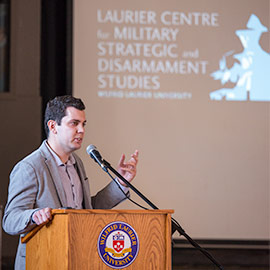
Written by guest blogger Matthew S. Wiseman.
The thought of studying the influence of military sponsorship on the development and conduct of Canadian science during the Cold War first crossed my mind as a PhD student at Wilfrid Laurier University. I was sifting through a large collection of unused archival documents in the basement of the Laurier Centre for Military, Strategic and Disarmament Studies. The documents had belonged to the late Dr. George Lindsey (1920-2011), a scientist trained in nuclear physics who worked as a strategic analyst for Canada’s Department of National Defence between 1950 and 1987.1
Lindsey served in the Royal Canadian Artillery during the Second World War, performing operational research and defending Britain against the threat of unmanned flying bombs—the world’s first early cruise missiles. After the war, he applied his skills in Ottawa, using advanced mathematics to study and analyze the air threat against Canada during the age of nuclear bombers and ballistic missiles.
Lindsey passed away in 2011 and his family graciously donated his career documents to the Laurier Centre. The papers included previously classified memoranda and strategic assessments on a wide range of military technologies and weapons systems. Lindsey had produced these documents for internal government circulation only, meaning I had dream access to the work of an influential Cold War strategist with first-hand knowledge about the inner workings of the Canadian defence establishment.
Working in the Lindsey papers strengthened and reaffirmed my commitment to the history of Canadian science and technology, but perhaps more importantly, set me on a path to explore and uncover the rich archival records left behind by scientists and engineers across the country.
With the growth of the National Research Council (NRC) after the First World War, the federal government began subsidising the work of selected scientists through extramural research grants. This practise continued through the interwar period and, during the Second World War, the NRC marshalled Canada’s scientific expertise to support the war effort. In 1947, the newly formed Defence Research Board (DRB) became the second federal body in Canada responsible for administering government research funding.
Officials in the DRB distributed government funds allocated under the national defence budget for research and development projects that showed a potential military value for the Canadian armed services. Scientists, engineers, technicians and graduate students at more than twenty-two universities in Canada received DRB funding to conduct military research between the late 1940s and early 1960s.2 Academics in both the physical and social sciences entered and embraced the world of military research, conducting secret and open work for the DRB to access government capital and fulfil a patriotic duty.
Because Ottawa consistently funded academic science in twentieth-century Canada, university archives across the country hold valuable (and largely untapped) records. The Lindsey papers at Laurier piqued my interest in university collections, but I quickly realized that Canadian scientists and engineers regularly maintained career files that often ended up with the archive of their affiliated institution.
Time and funding will always be barriers to travel and archival research, although digitization provides some solutions for a promising future. Access to information is also a consistent challenge when studying government- and/or military-funded research, but do not shy away from local and institutional record collections.
University archives are national repositories that maintain information about the choices, priorities and lived experiences of individuals who offer a window onto the past – perhaps a collection close to you will enrich your research just as it did mine.
Matthew S. Wiseman is an AMS Postdoctoral Fellow in the Department of History at Western University. His research concentrates on the history of science in twentieth-century Canada, with particular focus on the social and environmental impacts of government-funded research during the Cold War. Read his latest article in the Canadian Historical Review entitled “Canadian Scientists and Military Research in the Cold War, 1947–60” free for a limited time here.
Endnotes
[1] George R. Lindsey (author), and Matthew S. Wiseman (editor), The Selected Works of George R. Lindsey: Operational Research, Strategic Studies, and Canadian Defence in the Cold War (Toronto: University of Toronto Press, 2019), xvi.
[2] Matthew S. Wiseman, “Canadian Scientists and Military Research in the Cold War, 1947–60,” Canadian Historical Review 100, no. 3 (September 2019): 447.
Comments on this entry are closed.